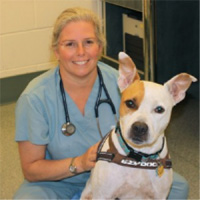
“Sometimes the veterinary professional feels they don’t want to continue providing care for gravely ill or suffering patients, but the family does. So who gets to decide? That’s a huge source of moral distress in the veterinary profession. While not necessarily the biggest one, I think providing futile care to dying animals has the most negative impact.”
Dr. Lisa Moses, Veterinarian, Animal-focused Bioethicist, Faculty Member at the Harvard Medical School’s Center for Bioethics
Moral distress is a term used to describe the psychological and emotional turmoil that can arise when individuals are faced with a situation where they feel ethically conflicted or unable to act following their moral values. While moral distress is commonly associated with healthcare professionals, such as doctors and nurses, it can also be experienced by veterinary professionals.
Vet techs are crucial in animal healthcare, supporting veterinarians and ensuring animals’ well-being. However, they may encounter situations that challenge their ethical principles and cause moral distress. “It is a particular kind of insidious and cumulative work stress that is generated by living in a world where all day long, you are having to grapple with not knowing whether what you’re doing is the right or wrong thing,” explains Dr. Lisa Moses, veterinarian, animal-focused bioethicist, and faculty member at Harvard Medical School’s Center for Bioethics. “Even worse, you may often feel like you’re forced to do something you think is wrong.”
While everyone in healthcare and veterinary care can experience moral distress, Dr. Moses believes it can be more challenging for some than others: “I think it’s worse for vet techs because they have a whole other layer of having less agency and power to impact how they care for their patients,” she explains.
Addressing moral distress among vet techs requires a multi-faceted approach. It is essential to recognize that moral distress is a complex issue that may vary from one individual to another. By acknowledging and actively working towards mitigating moral distress, we can create a more ethical and compassionate environment for veterinary professionals and the animals they care for.
Keep reading to learn from Dr. Moses about what she believes are the top causes of moral distress in vet techs and what can be done to address it.
Meet the Expert: Lisa Moses, VDM

Dr. Lisa Moses is a veterinarian and bioethicist with a VMD degree from the University of Pennsylvania School of Veterinary Medicine. She completed a fellowship in bioethics at the Center for Bioethics, Harvard Medical School.
Dr. Moses’s work centers around two primary areas: animal-focused research ethics and veterinary medical ethics. Her current focus includes biodiversity conservation research ethics, veterinary clinical trial research ethics, and addressing non-human animal concerns in xenotransplantation research. In addition to her research, she also serves as a co-director of the capstone program for the master’s of science in bioethics program at Harvard Medical School.
Causes of Moral Distress Among Veterinary Professionals
In Dr. Moses’ experience, there isn’t a single cause for moral distress in veterinary technicians. Here are what she believes are the top causes of moral distress.
Competing Interests
There are often competing interests in veterinary care: “Our patients are not the ones making the decisions, and we don’t have the freedom or luxury of always having our patients’ best interests come first. It is very clear when you take care of people, even if there are economic factors or institutional constraints. Your duty is always to your patient first,” explains Dr. Moses. “That is not true for the veterinary profession. We have to equally hold the interests of the owners along with the interests of our patients. And that is just an inherent conflict.”
Financial Constraints
While some pet owners have animal insurance, finances are a significant consideration for most people when they go to the vet. “Financial constraints are a huge thing,” says Dr. Moses. “Who gets to decide what’s the right thing to do when your patient is legally the property of someone? Is your knowledge, expertise, and advocacy for your patient less important than their right to make a decision, often based on financial limitations?”
Futile Care
Over the years, Dr. Moses has noticed one particular type of care at the behest of the owners that causes more moral distress than any other: “Sometimes the veterinary professional feels they don’t want to continue providing care for gravely ill or suffering patients, but the family does. So who gets to decide? That’s a huge source of moral distress in the veterinary profession. While not necessarily the biggest one, I think providing futile care to dying animals has the most negative impact.”
She continues, “What I have found in my research, for veterinarians in particular, the moral distress surrounding euthanasia decisions is not as bad as the moral distress around providing futile care.”
Consequences of Moral Distress in Veterinary Settings
Moral distress in vet techs can significantly affect their well-being and job satisfaction: “The consequence that gets the most press is suicide and suicidal ideation. There’s no question that animal care professionals have higher rates of suicidal thoughts than the general public,” shares Dr. Moses. “However, by focusing on that, we are missing a much bigger issue: that many people simply cannot sustain this work, and they want to. They don’t want to leave the profession, but it’s too emotionally hard. So, for me, the loss of highly motivated and compassionate people is tragic.”
In addition to professionals leaving for other careers, moral distress impacts how those who choose to stay can provide care. “What’s also tragic is you cannot take good care of your patients when you are suffering. It has demonstrable impacts on patient care,” she says. It can also lead to job dissatisfaction in the long run, leaving vet techs feeling disheartened and experiencing compassion fatigue.
Steps to Address Moral Distress
Moral distress is becoming well-recognized in the veterinary profession, which is the start of making changes. “Unfortunately, we still tend in this field to see this as an individual problem rather than a systemic problem with the profession. It’s almost like blaming the victim and expecting people who are already really drained of their emotional resilience to fix it themselves,” notes Dr. Moses. “I don’t think that’s possible, and I don’t think telling people to get more sleep and take better care of themselves will fix frequent ethical conflicts.”
There is no single solution to this pervasive problem. “It’s clear that it will take more than just a few solutions. It will take multiple layers of perspective changes in the profession,” she says. “One of the things that I’ve just started to think and write about is how maybe we need to reframe the fact that we hold empathy and compassion as our core values and embrace that. We, understandably, for self-protective reasons, lose some of our childlike, naive compassion and become desensitized. We move away from talking about compassion and demonstrating empathy for people and the animals we care for—let alone for ourselves and our colleagues. We put on a front of being able to handle all of it without impacting us because we feel like they have to deal with all of the sadness and grief of their sick animals.”
To address this, Dr. Moses believes the first step is to start talking about it more. “We don’t talk to the families about how this makes us feel. We think it’s not our place to say, ‘This bothers me too.’ I think that has really harmed us. We need to let the world know we’re human and feel things,” she adds.
“The general public needs to understand that there’s a person behind the scenes doing everything to your pet who is in the hospital. These are tough things to do that cause the patients pain and distress, and it’s really hard work. But they’re lovingly and kindly and caring for your beloved pet.”
Another way to address moral distress is to make decision-making a team process rather than an individual decision: “It’s so hard to make decisions for your pets. Many owners don’t see the veterinarian as having a legitimate role in that decision-making. They think the veterinarian is just there to tell them what to do. If more of the public saw us as a partner in making those hard medical decisions, everybody would feel better about the outcomes,” she says.
In addition, veterinary practices and organizations should prioritize creating an open and supportive environment where ethical concerns can be discussed and addressed: “Veterinarians need to know about moral distress in veterinary technicians and that they can help reduce it by including them as part of a team in decision-making,” encourages Dr. Moses. “They’re providing direct care for the patients, so I strongly believe that sharing the burden of decision-making makes it better for everyone, including the patient, not just saying, ‘The family and I have decided that you have to do this to this patient.’”

